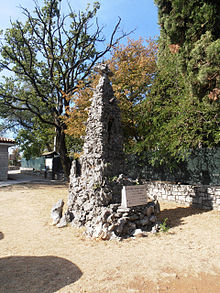Sistiana
Sistiana (Slovene Sesljan , German Seestein ) is a village in the northern Italian region of Friuli-Venezia Giulia . The place 77 m above sea level on the Trieste Karst belongs to the scattered municipality Duino-Aurisina (Slov. Devin-Nabrežina ) and has about 2,600 inhabitants (December 31, 2006). The postcode is 34011 and the phone code is 040.
history
Sistiana already existed under the name Sixtilianum in Roman times . It is said to have been the first Roman settlement on the territory of the former province of Trieste. It is also said to have been the scene of an armed conflict between the Roman troops marching in from Aquileia and the Histri population originally resident here . In the immediate vicinity of the place, the remains of a Roman villa were uncovered, which proves the assumption that Sixtilianum was subsequently a popular holiday resort for the Roman patricians . Limestone quarries were opened in the bay itself in the 2nd century AD to extract building material; some of these quarries are believed to have been used by pre-Roman populations from the 2nd century BC onwards. Have been used.
In the 16th century there were border disputes between the Lords of Duino and the city of Trieste in Sistiana ; at that time Sistiana is also mentioned as Cessiana and Cisigliano .
At the end of the 19th century, several hotels ( beach hotel and park hotel ) were built in the bay , making Sistiana one of the most famous seaside resorts on the Austrian Riviera , alongside Grado and Abbazia (today Opatija ) .
During the First World War , the bay was used as a naval base for the KuK Austrian Navy . In front of the Sistiana tourist office there is still a memorial to the memory of the participation in the World War 1914/1918 of the KK FREIW. PROTECT FIELD COMP. 3 / II.
During the Second World War , Sistiana became part of the Adriatic Coastal Operation Zone . The management of the small combat unit 411 of the German Navy had its seat in the bay of Sistiana at that time. In the bay was a large, heavily guarded, secret German naval bunker. From November 1944 this was a base next to the naval units for 30 Newch submarines . The facility was blown up by German troops in early May 1945 and is still the subject of much speculation.
In the 1950s and 1960s, the settlement of Borgo San Mauro was created for the Italian-born refugees ( esuli , Optanten ) from Istria , which almost doubled the population of Sistiana.
Attractions
Sistiana is known for its bay and its bathing beach.
This is where the Rilkeweg begins , which runs from Sistiana along the rocky coast to Duino Castle , where Rainer Maria Rilke stayed as a guest from October 1911 to May 1912 and wrote the Duinese elegies .
Sistiana is the starting point of the Terrano Wine Road ( Strada del vino Terrano in Italian ), which was introduced in 1986 by the Province of Trieste and leads through the Karst to the village of Opicina .
Trivia
The volume of stories of the same name by Julian Schutting (1976) also refers to Sistiana .
Web links
- Official website of the municipality of Duino-Aurisina (Italian, Slovenian)
- Travel guide for Duino and Sistiana
- Duino-Aurisina
- Sistiana (German)
Coordinates: 45 ° 46 ' N , 13 ° 38' E




